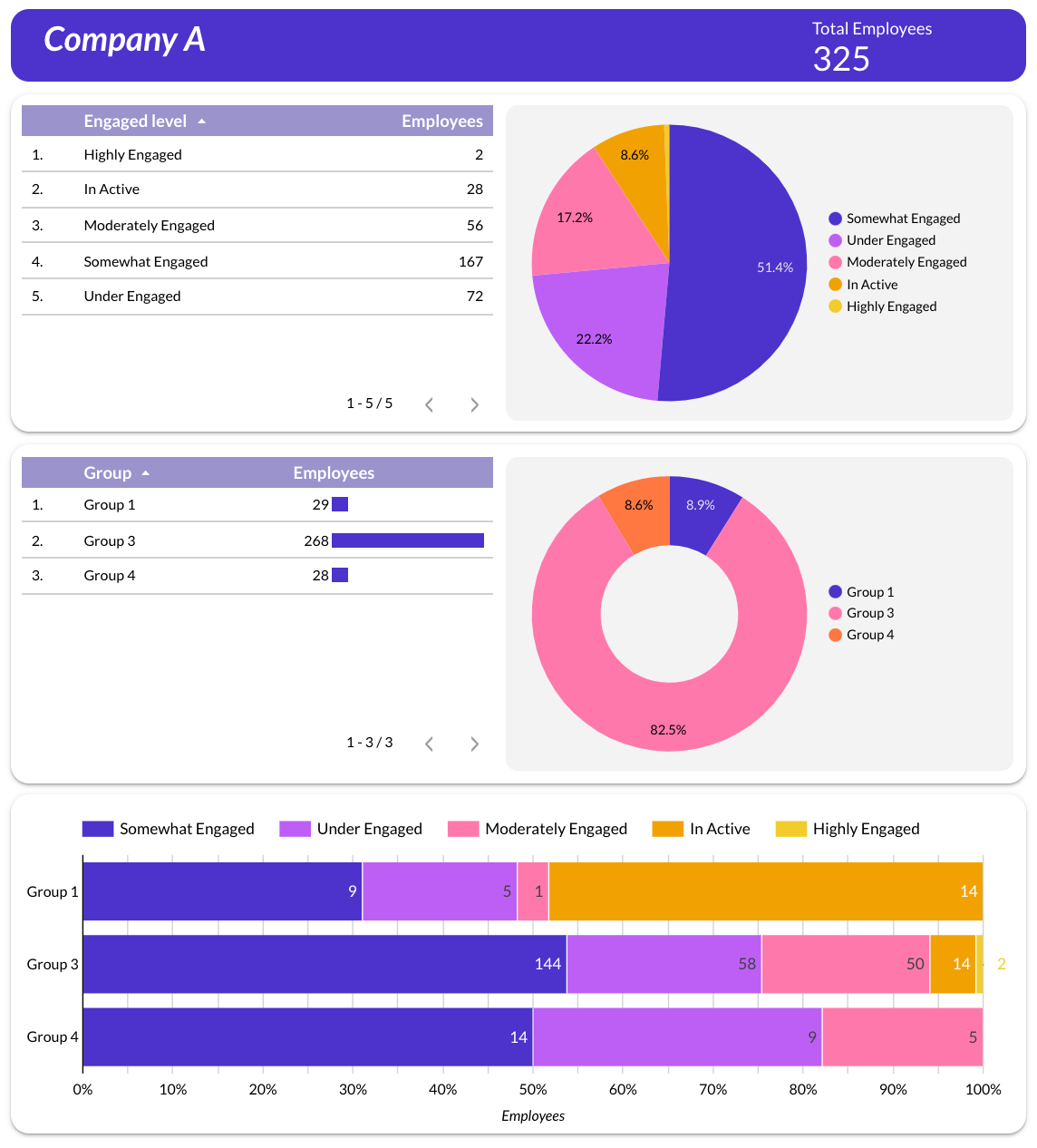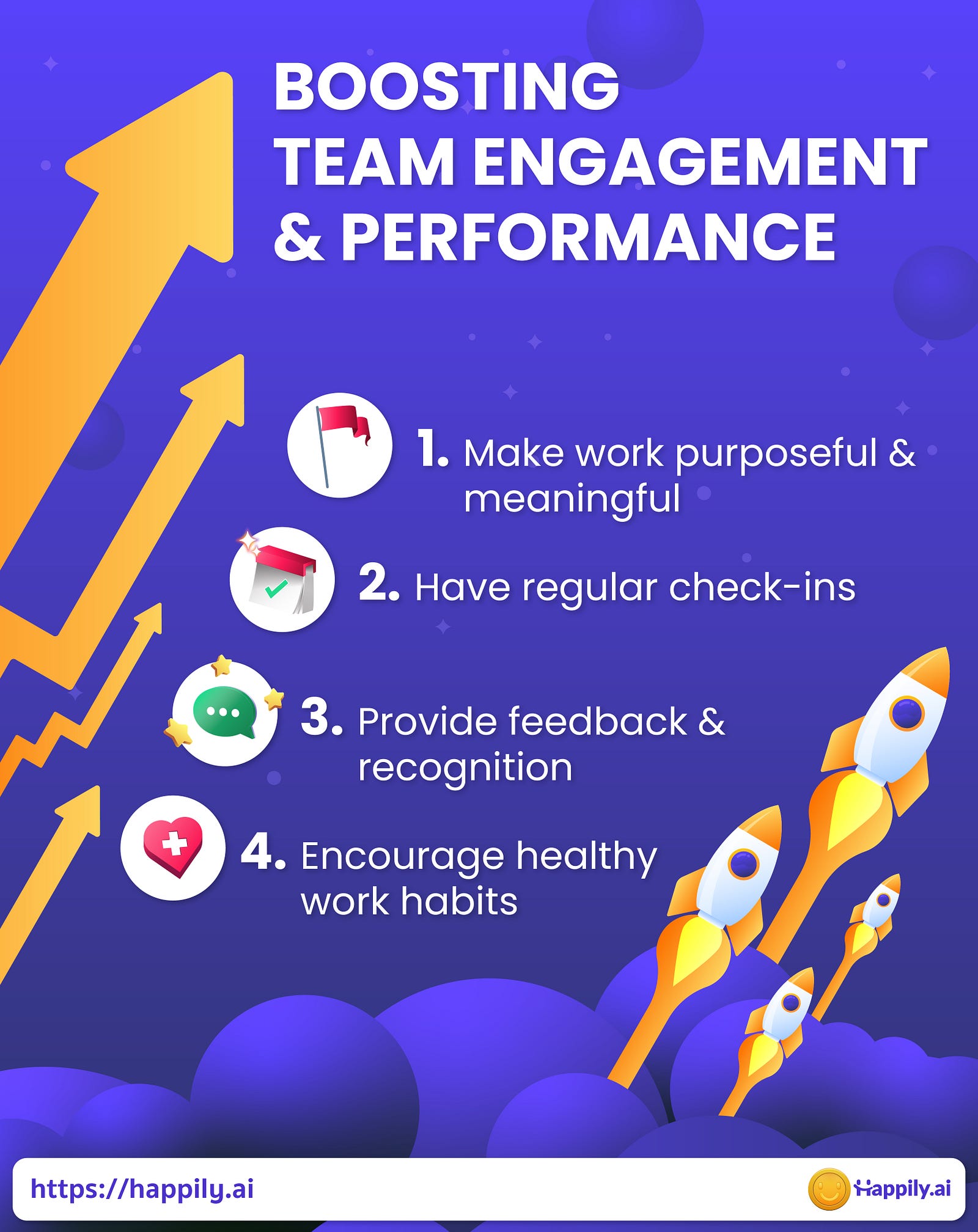Using unique behavior-based indicators, we gain further insight into how employee engagement and performance are interrelated.
Understanding Employee Engagement and Performance
Employee engagement is widely understood to impact performance, and a combination of high engagement and disciplined performance management leads to increased productivity, higher employee retention, and other positive business outcomes. Engaged employees are more productive because they feel like what they do matters. They want to put forth their best effort, which results in better outcomes for themselves, their colleagues, and the organization.
In this era of high competition and change, performance is associated with an ability to innovate — create new ideas, challenge the status quo, learn through failures — as well as continuously increasing productivity, profitability, and customer satisfaction and reducing unwanted attrition.
In an HR analytics case study from www.aihr.com, a unit (1%) increase in employee engagement resulted in a 4% drop of ‘recordable case frequency’ which is a key industry safety standard at Shell. And the safety performance was in turn directly related to business performance.
Measuring Employee Engagement and Performance
OKRs (Objectives and Key Results) and other performance management systems are commonly used to organize and track performance. Unlike engagement, performance can be more easily understood and measured. For example, sales performance can be measured with sales numbers and Customer Service with CSAT scores. But what about employee engagement? What is the most reliable way to measure how engaged an employee is?
Employee engagement has traditionally been measured with annual engagement surveys based on self-assessment, generally unreliable. More recently, companies use people analytics to measure engagement by looking at email and calendar activity. At Happily.ai, we propose that engagement is best understood by looking at behaviors directly related to an employee’s contribution to the company and their coworkers’ betterment (e.g., feedback, quality of feedback, recognition, community building, and more).
Study & Results: The Connection Between Engagement and Performance
At Happily.ai, we help companies drive culture transformation and engagement through behavior change. Some of the behaviors that we facilitate and measure include feedback, recognition, community building, and self-improvement.
Performance can be assessed by considering how recognition is given and received by different roles in the organization (a subset of relational analytics). Peer-to-peer recognition provides a measure of Network Effectiveness, how much a person contributes to the people around them. Direct manager recognition offers a measurement of Individual Performance, how much a person contributes to the organization in their assigned role as evaluated by their manager.
Four groups are designed based on recognition characteristics:
- Performance Group 1: Low peer recognition & Low manager recognition
- Performance Group 2: Low peer recognition & High manager recognition
- Performance Group 3: High peer recognition & Low manager recognition
- Performance Group 4: High peer recognition & High manager recognition
The superstar performers are in Performance Group 4, they excel in both individual performance as well as actively contribute to those around them.
Engagement levels are determined by an employee’s participation in activities such as daily check-ins, feedback, quality of feedback, peer feedback, recognition, quality of recognition, community building, self-improvement, and building new connections at work. Based on the frequency or quality of these activities, an employee is designated into an engagement level:
- Highly Engaged
- Moderately Engaged
- Somewhat Engaged
- Under Engaged
- In-active
We study the engagement and performance of two companies with 325 and 156 employees, respectively. At Company A:
- 225 employees are highly, moderately, and somewhat engaged
- 100 employees are under-engaged or inactive
- 9% of employees belong to Performance Group 4 (superstars), and 50% of Performance Group 4 are somewhat engaged
- 82.5% of employees belong to Performance Group 3, and 54% of Performance Group 3 are somewhat engaged
- 9% of employees belong to Performance Group 1, and 50% of Performance Group 1 are in-active

At Company B with 156 employees:
- 83 employees are highly, moderately, or somewhat engaged
- 73 employees are under-engaged or in-active
- 64% of employees belong to Performance Group 4
- All highly engaged employees are in Performance Group 4
- All under-engaged and in-active employees are in Performance Group 1

In both companies, highly and moderately engaged employees are in Performance Group 3 or Performance Group 4; they are recognized by their peers and have high network effectiveness. On the contrary, in-active employees make up the majority of Performance Group 1 for both companies. These results suggest a clear link between engagement behaviors and performance.
Improving Talent Utilization and Engagement
While 64% of Company B employees are in Performance Group 4, only 9% of Company A employees made that performance group. The difference is better talent utilization in Company B, along with managers who recognize their team. That is why there are 7x more highly engaged employees in Company B than Company A.
Boosting Team Engagement and Performance: Manager's Role
The link between engagement and performance is clear, and managers are the key ingredient to successful employee engagement and performance. Here are four ways managers can boost team engagement:
- Make work purposeful and meaningful: Engaged employees are more likely to understand how they contribute to the company’s objectives. Managers should clearly communicate how their team’s contributions, results, and outcomes connect with strategic goals, the company’s core values, and mission.
- Have regular check-ins: Managers should schedule weekly 1-on-1 meetings with each direct report to stay connected and to form deep and trusting relationships.
- Provide feedback and recognition: Engaged employees go above and beyond. And their biggest motivator is to feel valued and appreciated. Show gratitude and encourage them to pay it forward.
- Encourage healthy work habits: Be accommodating to team needs that help them stay healthy, such as flexible work hours or even support their passion projects. Show that you value and respect their personal well-being; allow for group activities such as coffee breaks or promote stretching and exercise.

Conclusion
Employee engagement drives many business outcomes and our findings show a clear link between engagement and performance. An engaged employee actively participates in continuous learning and improvement through feedback, recognition, and other positive interactions. These habits lead to better performance — contributions to their peers and to organizational goals. And managers play a key role in driving sustainable engagement and performance.
Engagement requires behavior change from employees, managers, and leadership. There are no shortcuts to creating a healthy and happy workplace. We invite you to check out Happily.ai to see if we can help you drive positive behavioral change in your workplace. Uncover the opportunities and challenges in an effortless way, please visit us here.

References:
[1] https://www.linkedin.com/pulse/relationship-between-performance-management-employee-mark
[2] https://www.greatplacetowork.ca/en/articles/the-link-between-employee-engagement-and-performance
[3] https://www.aihr.com/resources/AIHR_HR_Analytics_Case_Study_Collection.pdf
[5] https://topworkplaces.com/how-to-improve-employee-engagement/
[7] Photo by Jason Goodman on Unsplash









